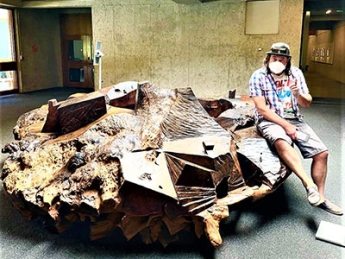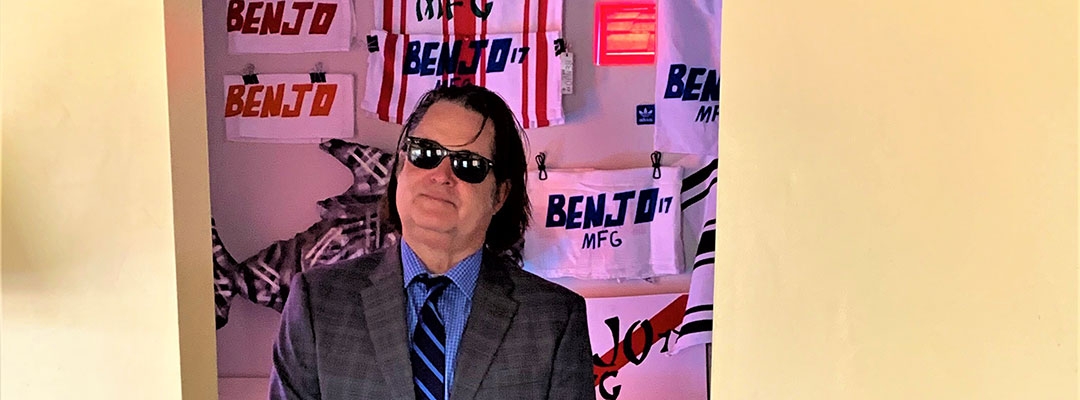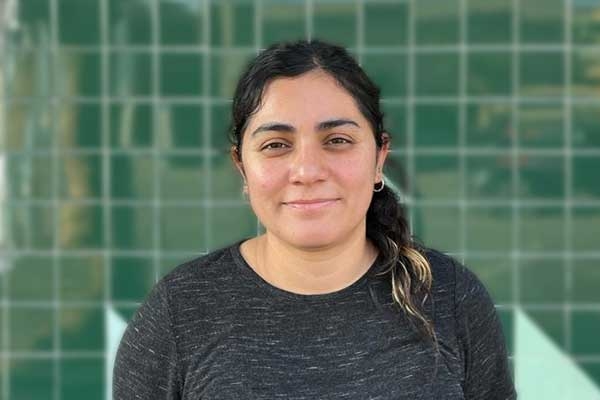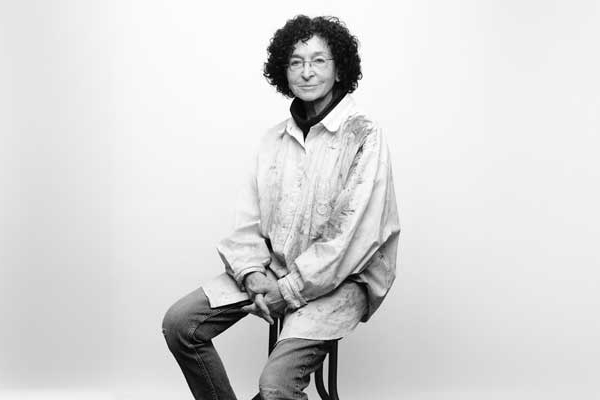Laguna Beach, Calif., is known for being a progressive arts community.
“I was raised in Laguna Beach by a mom who really encouraged creativity. Her inspiration along with the natural beauty of the city’s location and its then-liberal attitude toward the arts were big influences,” Post-Baccalaureate Certificate in Visual Arts graduate Jeff Maylath recollects of the area’s ambiance and the early inspiration for his artistic endeavors. “The community placed high value upon the arts.” (The local high school’s mascot was “the Artists” from 1936 to 2003.)
For his undergraduate degree, Jeff began his studies at California State University, Fullerton, as an English major. But in his third year, he began to self-reflect “on what I was doing, as opposed to what I wanted to be doing, and decided to bum around Europe for a year and collect perspective.”
The experience was life-changing, careerwise and personally.
“This was an alternative education for me,” Jeff explains, “and I could feel my mind expanding culturally, politically, creatively and personally. When I returned to the United States, I decided to move to Santa Cruz—another haven for progressive thought—and got a job as a construction laborer.
“I learned that I loved building things. I wanted to finish college, so I applied to UC Santa Cruz (UCSC), transferred my credits and eventually graduated with a B.A. in Visual Arts.”
Work Imitating Life—Or Something Like That
Jeff’s work in construction began to play a major role in his work as an artist.
“Architecture was my major influence!” he enthuses. “Architecture classes at UCSC taught by Reyner Banham introduced me to the world of design, and my construction work related well to that world.
“Also, Professor Fred Hunnicutt allowed me to take ceramics classes. He knew I was a builder, and encouraged me to work with concrete. I ended up working on some of his large pieces that were installed around the Bay Area. My school studies and construction work led to my interpretation of sculptures and structures being uniquely related.”
This relationship between the arts and his construction business continues to influence his fine-arts practice and business skills.
“My passion for architecture, design and building informs my interest in the arts, as well as my art practice,” Jeff says.
“My work involves problem-solving from the beginning of a project to its completion. I am constantly called upon to create design solutions that make sense and look right, and this applies to both my construction business and my art practice.”
Design inspiration comes from the materials with which he works.
“Inspiration can come from a jobsite, from looking at redwood timber stacked to build a deck, the foundation of an old building, a remodeled stairway, a retaining wall, a walk through the neighborhood I am building in, a walk through nature, a conversation or general observations,” he tells me. “I try to keep myself curious, and allow inspiration to find me and work its magic.”
That magic informs his art, and leftover work materials naturally find their way into his creations.
“I have a workshop/art studio where the lines are blurred between the two. Likewise, work from my art practice finds its way into my work business, particularly when I am working with a client on design and aesthetics. I purchase materials separately for each discipline (work versus art), but they tend to commingle in my workspace,” he adds.
“Inspiration can come from a jobsite, from looking at redwood timber stacked to build a deck, the foundation of an old building, a remodeled stairway, a retaining wall, a walk through the neighborhood I am building in, a walk through nature, a conversation or general observations.”
On Jeff’s visual arts website, he states: “My sculptures enable me to interpret my perception of the influence of humanity on the environment and disparities regarding wealth in society. I work with a variety of materials such as wood, aluminum and steel, but mainly I use concrete.”
Why this focus? What about concrete appeals to him as a medium?
“In construction, concrete is formidable, durable and agreeable to work with,” Jeff explains. “In my practice, I use those qualities to try to convey a message. If I am successful, I deliver that message in a solid material.
“Concrete has a coarse, gritty, earthy subtext and aesthetic that appeals to my design sense. It can speak many languages—from ancient to modern—and has a malleable property, yet it is unmovable. It is steadfast and dependable. It is beautiful yet brutal.”
So when it came time to help convey that message through his concrete sculptures and other artwork, Jeff found another source of inspiration—his wife, Lynne Rose.
Beefing Up the B.A. in Visual Arts
“Lynne Rose started going to law school, and I was inspired by her dedication to self-improvement,” Jeff recalls. “I thought I could maybe do the same in the context of visual arts.”
And living in the Bay Area, Jeff was already familiar with our visual arts courses.
“I loved creating art and had taken some classes with you, where I learned about the Post-Baccalaureate Certificate in Visual Arts program,” he affirms.
“This seemed to be a perfect transition between my 30-year-old B.A. and the possibility of an advanced degree. This also was an opportunity I had not previously considered. I was thrilled to learn of the post-baccalaureate program.”
Since the time Jeff attended and completed the certificate in December 2016, a few changes have been made, both to the program itself and to the art world in general. But the level of inspiration that our instructors provide hasn’t been altered.
“I took a lot of art history,” he says. “My favorite standouts being Contemporary Art: History and Theory and In Place: Recent Trends in Public Art.
“Also, Post-Baccalaureate Seminar 1: Portfolio and Visual Dynamics, Post-Baccalaureate Seminar 2: Portfolio and Critique and Post-Baccalaureate Seminar 3: Portfolio and Professional Practices were amazing! It was in these classes that I decided to get an M.F.A. thanks to the encouragement of instructors Shannon Schmidt and Amy Berk.”
Jeff also credits fellow classmates for inspiring him to take his skills and education further.
“The post-bacc visual arts program was rigorous and placed me back in the world of academia,” he says. “It inspired me and gave me the momentum to complete my education and to formalize my practice. When I started at UC Berkeley Extension, I had no intention of pursuing an M.F.A. In fact, I did not think an M.F.A. was even a possibility given my construction business.
“Then one day, a certificate cohort, Jennifer Lugris, gave me an arts magazine with an article on low-residency art programs,” Jeff recalls. “These programs allow a student to continue to work during the day and pursue an advanced degree at night. San Francisco Art Institute (SFAI) was one of the few schools in the nation that offered such a program. It was local, and it was a great and venerable school. I was proud to graduate with my hard-won M.F.A. during the onset of the global pandemic in 2020.
“I am heartbroken that SFAI closed its doors after 151 years,” he adds. “I was fortunate to go there, and UC Berkeley Extension was instrumental in helping me to navigate my path. For that I am grateful to Extension, and highly recommend its challenging post-bacc certificate to any artist entering or re-entering the world of academia.”
A Community in an Art Career
Jeff had been showcasing his art even before professionalizing his skills with our program or mastering the details in his M.F.A.

“When I began showing my work, I was involved with a loose-knit community,” he says. “It was extremely casual and not always sanctioned, but we were all prolific and enthusiastic about showing our work and talking about our work to anyone who would listen. A casually curated space at 16th and Valencia Streets in San Francisco called the Anti Gallery proved to be transformative for me, as it was my first foray into creating and installing public art.
“A 2012 juried show at Pro Arts in Oakland provided my first opportunity to give a formal artist’s talk. I realized then how terrifying yet personally fulfilling the experience of showing one’s art in public can be.
“Most recently, showing works at the juried Right Here, Right Now: A Biennial of Richmond Art at the Richmond Art Center was a terrific honor.”
As his art community evolves, Jeff takes time to reflect on how this community matters as an artist.
“A wonderful aspect of the post-bacc visual arts program was it helped me recognize the essential value of community,” he says.” A group of us in Richmond have started a collective to talk about art and strategize ways to use art to help create and sustain community. This will evolve into open studios and shows in the near future.”
This community influence also is being displayed in Jeff’s art. One of the many ideas that came out of the pandemic was an art collection called “BREATH.”
“At the beginning of the pandemic, I bought a cheap, used kiln and started to experiment with clay. The BREATH pieces are a confirmation of our ability to keep going on, keep breathing, and the repetition of these pieces reiterates that,” he explains.
The ability to keep going may overlap in other parts of Jeff’s life—especially when it comes to full-time construction work and a part-time art practice.
“Construction is kind of tough on the body,” he points out. “If I can take what I have learned and apply it to make my business more art-oriented, then I would be pretty happy. The path to getting my education while working—and all I experienced along the way—has made me see that my construction career and my art practice are not mutually exclusive. An amalgam of the two is my ultimate career goal.”
Being able to immediately apply his visual arts certificate program learnings to his professional and personal work, Jeff touts the benefits of pursuing continuing education in a subject you love. You might even receive unexpected rewards.
“The program forced me to update my technological abilities, both through using computers and social media,” he commends.
“I also had to learn how to communicate better through writing and verbally, which helped me tremendously in my practice and my business. My professional experience taught me to be committed, thorough, meet deadlines and follow through. These qualities are essential to being a business person, a student and an artist.”



